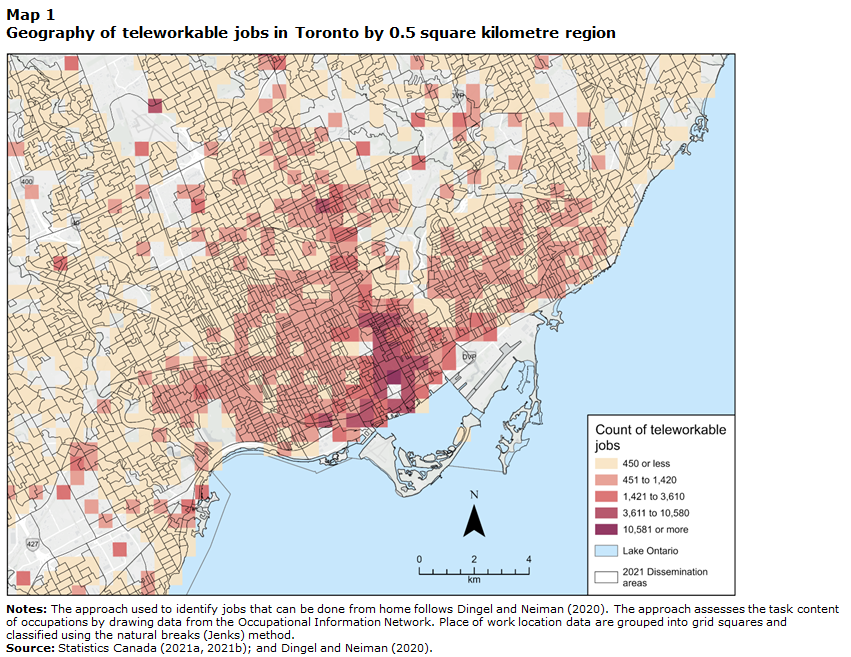Statistics Canada research shows Toronto’s financial district contains more than 3,600 teleworkable jobs per half-square-kilometre, suggesting significant potential for office-to-residential building conversions as Canada faces a housing shortage.
The federal agency analyzed 2021 Census data to map where jobs that could theoretically be done from home are located across the Greater Toronto Area, according to a report released Wednesday.
Canada needs approximately 3.5 million additional housing units by 2030 to restore affordability to 2004 levels, according to the Canada Mortgage and Housing Corporation cited in the Statistics Canada study. Converting underused office buildings to residential units offers a lower-cost alternative to new construction.
Downtown concentration creates conversion opportunities
The research found Toronto’s financial district and downtown core contain the highest concentration of teleworkable positions. Each half-square-kilometre grid in this area contains at least 3,600 jobs that could be performed remotely based on occupational tasks, the study said.
Regions immediately surrounding the core and areas along Yonge Street contain between 1,400 and 3,600 teleworkable jobs per half-square-kilometre, according to the findings.
The national office vacancy rate reached approximately 18.7% at the end of 2024, Statistics Canada reported, citing CBRE data. However, feasibility studies suggest only 25% to 34% of office buildings in North American markets have real conversion potential, the report noted.
Suburban areas show lower telework density
Outside Toronto’s core, teleworkable job density drops significantly. Areas from High Park west to East Danforth and south of Eglinton Avenue contain between 450 and 1,400 teleworkable jobs per half-square-kilometre, the study found.
Many suburban regions contain fewer than 450 teleworkable jobs per half-square-kilometre, according to the research.

Regional analysis extends across GTA
The study’s broader analysis covering Oakville to Ajax and north to Newmarket revealed pockets of moderate teleworkable job concentrations in cities adjacent to Toronto. Mississauga’s city centre contains up to approximately 3,600 teleworkable jobs per half-square-kilometre, matching Toronto’s downtown density.
Work-from-home policies remain factor
Researchers used 2021 Census data when telework was more prevalent than current levels, as some employers have mandated office returns. The study focused on jobs that could theoretically be done remotely rather than actual work-from-home practices.
Changes in teleworkable job numbers within city areas occur slowly since they require business relocations, entry or exit, the researchers noted.
Housing market implications
A Bank of Canada study showed Toronto’s suburban areas experienced the largest house price increases during the pandemic as remote work reduced the need to live near offices, Statistics Canada reported.
The research suggests building conversions throughout the GTA could help reduce pressure on suburban housing prices, though the study does not estimate how many buildings could actually be converted or how many residential units might result.
The study was conducted by researchers Mark Brown, Matthew Brown, Tahsin Mehdi, Derek Messacar and René Morissette from Statistics Canada’s Economic and Social Analysis and Modelling Division.






